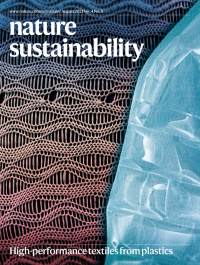Nature sustainability
Volume 4 Issue 8, August 2021
High-performance textiles from plastics
As a major polluter, the fashion industry would benefit from the development of sustainable textiles. Boriskina and colleagues engineer plastic waste into wearable fabrics with combined low environmental impact and advanced functionalities such as moisture wicking, stain resistance and recyclability.
Image: Felice Frankel(textile background) and IevgeniiaPidgorna / Alamy Stock Photo (foreground bottle). Cover Design:Valentina Monaco.
Editorial
Editorial | 17 August 2021
Too much and not enough
Rain and drought have seized the world’s attention, showing the importance of water studies for society. But what if the field is not pursuing the most critical research?
Comment & Opinion
Q&A | 29 April 2021
Joined-up action for biodiversity
Awaiting the Fifteenth meeting of the Conference of the Parties to the Convention on Biological Diversity (CBD) to be held in China late in 2021, Elizabeth Maruma Mrema, Executive Secretary to the CBD, talks to Nature Sustainability about the challenges of stepping up efforts to address biodiversity decline.
- Monica Contestabile
Focus:
Advertisement Feature
Machines and humans combine to speed tyre development
Tyre-development platform draws on the complementary strengths of human ingenuity and artificial intelligence to realize better performing tyres
News & Views
News & Views | 13 May 2021
Searching for a MicroFEWs nexus in Alaska
Expanding renewable energy sources in remote rural Alaska villages promises to improve sustainability and resilience. What happens to the food–energy–water nexus when critical resources are abundant public goods?
- James Magdanz
Reviews
Perspective | 22 April 2021
Institutional navigation for polycentric sustainability governance
To more effectively navigate environmental politics and governance, this Perspective recommends actions in four areas: knowledge, relationships, strategies, and decision and implementation.
- Mark Lubell
- Tiffany H. Morrison
Research
Article | 13 May 2021
Applying the food–energy–water nexus concept at the local scale
While the food–energy–water nexus has become a focal point for inter- and cross-disciplinary studies in recent years, this analysis of rural communities contextualizes how effective the nexus is for describing and studying interactions.
- Henry P. Huntington
- Jennifer I. Schmidt
- Michelle Wilber
Article | 22 April 2021
In-stream turbines for rethinking hydropower development in the Amazon basin
In-stream turbines could be a viable alternative to storage-based large hydropower projects. This study finds that about two-thirds of the planned hydropower generation in the Brazilian Amazon basin could be harnessed using in-stream turbines.
- Suyog Chaudhari
- Erik Brown
- Yadu Pokhrel
Article | 15 April 2021
The value of US coral reefs for flood risk reduction
A valuation of the flood risk reduction services of coral habitats to people, property, economies and infrastructure in the United States finds that these benefits exceed US$1.8 billion annually.
- Borja G. Reguero
- Curt D. Storlazzi
- Michael W. Beck
Article | 19 April 2021
Addressing the contribution of indirect potable reuse to inland freshwater salinization
Freshwater salinization syndrome is an emerging threat to freshwater globally. Here the authors quantify the contribution of indirect potable reuse to sodium pollution and suggest a variety of behavioural and technological interventions to address this growing environmental problem.
- Shantanu V. Bhide
- Stanley B. Grant
- Todd Schenk
Article | 12 April 2021
Selective extraction of uranium from seawater with biofouling-resistant polymeric peptide
The oceans contain 1,000 times more uranium than terrestrial resources, which could contribute to the sustainability of nuclear power. Here the authors report a polymeric adsorbent that can capture uranium from seawater selectively with an extraction capacity of 7.12 mg g–1. It is even resistant against biofouling and can be reused.
- Yihui Yuan
- Qiuhan Yu
- Ning Wang
Article | 15 March 2021
Sustainable polyethylene fabrics with engineered moisture transport for passive cooling
The textile industry is one of the largest polluters. Here the authors show that polyethylene is a sustainable alternative textile with water wicking and fast-drying performance. The fabrication of polyethylene fabrics is compatible with standard equipment and could be dry-coloured, further reducing water consumption.
- Matteo Alberghini
- Seongdon Hong
- Svetlana V. Boriskina
Article | 05 April 2021
Direct electrosynthesis of methylamine from carbon dioxide and nitrate
The electroreduction of CO2 provides a sustainable pathway to value-added fuels and chemicals. Here the authors show a cascade reaction that yields methylamine from CO2 and nitrate. With detailed insight into the multistep catalytic process, the current findings further push the boundaries of this technology.
- Yueshen Wu
- Zhan Jiang
- Hailiang Wang
Analysis | 26 April 2021
The importance of resource security for poverty eradication
An analysis of national economies’ unequal exposure to biocapacity constraints and purchasing power reveals how increasing demand of natural resources can lead to inescapable poverty traps.
- Mathis Wackernagel
- Laurel Hanscom
- Peter Raven
Analysis | 05 April 2021
Embodied greenhouse gas emissions from building China’s large-scale power transmission infrastructure
Expanding energy infrastructure has been vital to China’s development plans, but has had negative consequences. This study finds that in 2017 the level of embodied greenhouse gas emissions from the expansion of China’s power transmission infrastructure increased by more than 7.3 times that in 1990.
- Wendong Wei
- Jiashuo Li
- Jinjun Xue



No Comment